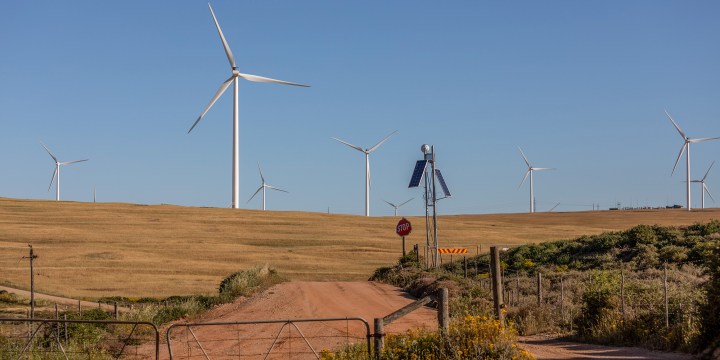RENEWABLE ENERGY
Best plan to keep the lights on: Solar and wind power officially cheaper than coal

As the results of bid window five of South Africa’s renewable energy IPP procurement (REIPPP) programme are digested, what is becoming abundantly clear is that renewable energy is the future for this country’s power sector.
The cost of electricity supplied into South Africa’s grid by the 25 preferred bidders bidding in window five of the REIPPP programme has plummeted to its lowest levels ever, with the cheapest solar bid coming in at 37.5c per kilowatt-hour. The cheapest wind bid came in at 34.4c per kWh, with wind cheaper than solar for the first time.
In comparison, the average cost of the power procured in round one was R3.12 (in current terms) per kWh.
“This was a huge achievement as a country,” says Tshifhiwa Bernard Magoro, CEO of the IPP Office. He was presenting at a seminar organised by the UCT Graduate School of Business’s Power Futures Lab to analyse the results of this latest round of renewable bidding.
“South Africa is getting the benefit of renewable energy at some of the lowest tariffs in the world.”
While there have been developments in South Africa’s power industry – notably the lifting of the cap on private power generation without a licence from 1MW to 100MW – this shows that the REIPPP programme is still the main game in town.
“There are many reasons to celebrate this bid window,” says Wikus Kruger, a research fellow at UCT’s Graduate School of Business. “The first being that no one can argue that renewable energy from independent power producers is expensive.”
Disappointingly, there were no projects announced in Mpumalanga or Limpopo, home to the majority of this country’s coalfields
To illustrate, over the last financial year, Eskom’s average cost of coal purchases was R421/MWh. This is before the coal has been turned into electricity and excludes the capital, operations and maintenance costs of the power stations.
“Given that the average cost of renewable power procured in this round was R473/MWh, it means that it is effectively cheaper for Eskom to buy this renewable energy than run its more expensive coal plants.”
Together, the 25 projects – 12 wind and 13 solar PV – will generate 2,583MW of power, with wind generating the lion’s share of this (1,608MW).
Collectively, the private sector will inject about R50-billion into the economy as it sets about building and operating the solar or wind farms over the next 20 years. At the same time, more than 13,000 job opportunities are promised over the 20-year duration of the project.
Disappointingly, there were no projects announced in Mpumalanga or Limpopo, home to the majority of this country’s coalfields, though eight of the awarded projects are in the Free State and one is in KZN.
Again, on the positive side, the bid also showed that by now – bid window five – South Africa’s lenders and bidders have gained considerable experience and expertise in this sector and this is contributing to the lower costs.
“As a commercial bank, we saw increased competition in round five,” says Rentia van Tonder, head of Power at Standard Bank’s Corporate and Investment Banking. “The banks understand the complexity; they have gone through four rounds by now. We understand the market, but also the players understand the terms of the game and were pushing the lenders from the start.”
This competitive tension will continue as the market develops, she adds. “The 100MW adds another dynamic… we are seeing the competition around RFPs issued by mining companies already.”
Scale and experience are also important, adds Hein Reynecke, general manager of Mainstream Renewable Power, part of the Ikamva consortium that was awarded 12 new wind and solar projects with a combined capacity of 1.27GW.
“Achieving these types of tariffs is not just about pulling one lever. We have a consortium of credible partners who have been part of South Africa’s renewable energy system for a long time. We started building wind projects 12 years ago and solar eight years ago, and have put in the hard work to make sure that these projects are competitive. We have 100 employees locally but are part of a big global group and can benefit from collective knowledge. This all contributes to building trust among our funders.”
Competition in this sector is set to continue. This bid round was almost four times oversubscribed, and that excludes all of the projects in the Northern and Western Cape that were disqualified because of the constraints on the Eskom grid in these areas.
“There is an immense appetite for this market, despite the six-year procurement hiatus. Run well, this auction programme can bring several gigawatts of power online in a short time and at a low cost,” Kruger says.
The awarded projects are likely to take between 24 and 36 months to reach commercial operation – quicker than coal, nuclear or even gas plants.
There is also renewed optimism about the (re)building of a local renewable energy industry off the back of this programme, with the local content commitment now up to 44%, up from 34% in the first round.
“There is a whole ecosystem of South African service providers and suppliers that have grown up around the programme. Many of these have faced great hardship in the period between BW4 and BW5, and several had to close down – but with the programme restarting, we hope to see these and other companies rebuild their businesses and grow their market,” Kruger says.
Another notable feature of the window is that South African and BEE ownership levels remained high, despite some relaxing of these requirements. In some projects, the foreign lead entity owns only 40% of the project, with the rest owned by BEE partners and local community trusts.
There has also been a shift, says Kruger, from more passive to active BEE ownership, with companies like Pele Green Energy putting in its first IPP bid, although it was not awarded. African Rainbow Energy and Power is also becoming more involved and was part of the very successful Ikamva consortium.
“This is not to dismiss many of the important and legitimate concerns about the necessity of including black industrialists and ensuring fair returns for local shareholders – but in general, this is an encouraging trend.”
The Department of Mineral Resources and Energy is expected to launch the Request for Proposals sixth bid window in January. There is little time to waste. The government’s Integrated Resource Plan indicates that the country needs 26,000MW of new solar and wind capacity by 2030 to keep the lights on. DM/BM
[hearken id=”daily-maverick/8821″]



















 Become an Insider
Become an Insider
It would be BRILLIANT if DM or someone you could find could do an SA version of this.
Not only does renewable make sense, but couple with the right systemic thinking it would bring PLENTY of jobs back home
“Solar and wind power officially cheaper than coal”
Really? We need some more serious reporting.
Cheaper maybe at the point of generation. But costs for the grid connections, maintaining grid reliability, providing large-scale storage and backup capacity for long periods of low generation (or cost of massive over-development to have greater ability to ensure that power is always on’) , are not factored in. The happy developers with guaranteed revenue expect the public to pick up those costs…. all that’s being presented is a process of privatising the profits and socialising the losses.
Already, organisations that have installed solar to reduce their costs are complaining about proposals for them to pay availability charges when they connect to the (public) grid because the sun is not shining or the wind doesn’t blow hard enough.
There is no cheap magic bullet for low carbon electricity and articles like this are simply misleading.
> But costs for the grid connections, maintaining grid reliability, providing large-scale storage and backup capacity for long periods of low generation (or cost of massive over-development to have greater ability to ensure that power is always on’) , are not factored in
They might not be, but neither are the huge upfront capital costs of getting a coal power station up and running (let alone operations and maintenance cost as mentioned). You also can’t forget the inevitable delays and complexities that come with mega-scale projects such as nuclear and coal builds.
A quick calculation – Medupi was estimated at costing R234 billion, with a nameplate capacity of 4800MW, and in May 2021 it produced 2426MW from 5/6 completed units then. Call it ~3000MW if it were fully operational.
If it were running at this capacity, assuming a 40 year design life, you’d have 1051200000 MWh at the end of it. Divide the cost by this figure (234000000000 / (3000*24*365*40)) and initial capital outlay alone adds R222/MWh to the figure!
I realise that the author is well intentioned – but the type of errors made in this article contribute to polarisation of the debate on electricity in South Africa.
I have lived off-grid on solar for 20 years and I support the rapid rollout of wind and solar to decrease our carbon emissions. BUT, it is just conceptually wrong to compare a coal price of 421c/MWh with these latest prices for renewable energy of 473c/MWh.
This quote is just absurd: ““Given that the average cost of renewable power procured in this round was R473/MWh, it means that it is effectively cheaper for Eskom to buy this renewable energy than run its more expensive coal plants.”
If you visit the relevant Eskom page it shows you the actual production of wind and solar energy in South Africa on a hourly basis. The huge fluctuations show the obvious flaw in the above quote. The sun does not shine at night and wind speeds vary hugely. Those prices only apply “when the sun is shining/wind is blowing”. You cannot compare that with coal or gas or nuclear energy that if run correctly will give energy 24 hours per day.
And there are no batteries in existence that can run a country or even a big city on the 4 windless nights SA experiences annually.
Rolling out renewables requires dispatchable backup. Globally gas is the energy of choice to pair with renewables due to the speed with which it can be fired up.
Google this phrase “Eskom total hourly renewable generation” and then click on the first link to see what our current renewables generate on an hourly basis. The wild fluctuations point you to the problem of simply comparing renewable energy prices with alternatives that run 24 hours per day (coal, gas, nuclear, etc).
To rollout huge renewable capacity you MUST install a giant backup energy generation system to cover the fluctuations in wind speeds and the fact that solar panels only produce energy for about 10 hours per day. And the cost of that backup system must be factored into the cost of the renewables. Typically these backup systems use gas as it can be quickly fired up and down to cover renewable fluctuations.
There are no batteries on earth than can run a city or a country on the four windless nights we experience on average four times per year.
Dave Martin’s comments are reasonable on the fact of it, but the fact is that in the Risk Mitigation IPP, there were bids to supply 428MW of renewable energy-PLUS-STORAGE at costs LOWER than LNG.
David le Page – please provide a reference for that claim. I only saw solar plus diesel generator at night. Not storage.
Why does thermal energy not feature at all? We have hugely deep mines in Gauteng. Perhaps someone without vested interests can put the unwanted heat and water to some purpose…..
Reversible meters and solar panels incorporated into roofing with replenishment of water in the hydro electric storage systems when the sun is shining could be energy efficient as a partial solution.
Too many wind farms are going to pollute scenery and decimate our bird life…
David le Page: I had a look at the Risk Mitigation IPP and in the first round the renewables were all paired with gas or diesel. There was a 2nd round of winners announced in September which comprised three Solar PV + Battery Storage bids: Kenhardt 1, Kenhardt 2 and Kenhardt 3 (all by the company Scatec). These were bid at R1884/MWh which is about 30% more expensive than gas alone. These bids only provide about 2 hours of battery storage. If we were to use batteries for a whole night, these bids would require much bigger batteries which would be MUCH more expensive.
But these three bids do prove my point: you can’t compare the cost of renewables alone, you have to add in the cost of storage and/or gas as a backup. When you do this, then the numbers quoted in the above article (R473/MWh) are shown to be totally misleading. You can increase that number by at least 500% to get an accurate idea of what it would cost to run the country on renewables+batteries.
Reference for the above (can’t post link):
Google “South Africa adds $1bn solar-battery project portfolio to RMIPPPP preferred bidder list” and click on the Engineering News article at the top.